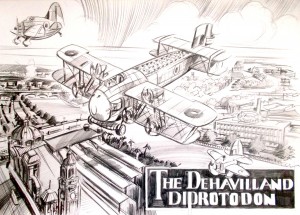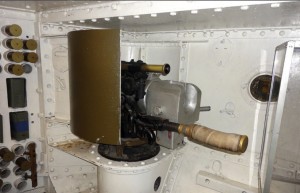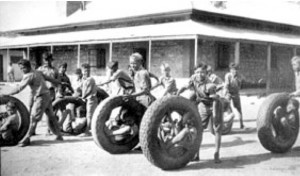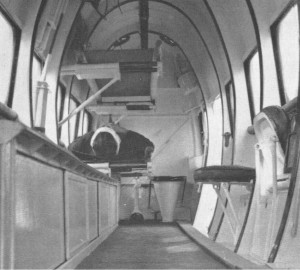The Dehavilland Diprotodon

Diprotodon Mark I during Melbourne flyover Anzac Day 1935. Note early prototype Wacket Wombat trainer aircraft as escort.
Perhaps the most ambitious project undertaken ever by the fledgling Australian Aircraft Industry, the Diprotodon, represented the very latest thing in thinking and technological advancement. Developed by de Havilland’s Australian subsidiary at their Fisherman’s Bend plant the Diprotodon was conceived in response to the perceived threat from Russian naval units, then believed to be on patrol in the Pacific. There was also a perceived threat from German naval units rebuilding after the debacle of Versailles, and Japanese naval units and air defence units operating near the New Guinea protectorate as the Empire of japan became increasingly agressive in its approach to foreign policy. Subsequent Defence White papers also influenced design pointing to a perceived, (though considered unlikely) threat from New Zealand, the Dutch Empire in Java, the potential for expansion and conflict between the British Eastern Fleet, the American Pacific Fleet, the forces of Tonga, and several gunboats stationed to protect the Portugese enclave of East Timor.

The Dirotodon’s main offensive armament. A 50 mm Q.F Gun adapted from a Mark 1V Tank in fuselage mounted sponson.
Faced with such manifest danger the PM, The Rt Hon Joseph Lyons responded to the defence white paper with the initiative to develop an ‘air battleship’, equipped with cannon, a platoon of marines, and the very latest in air defence and long range capability.. The result, the Diprortodon, was destined to become an astounding success.. The specifications and consequent brief called for a large transport and maritime intercept aircraft with good range and durability that could transport at short notice either a platoon of troops or a squad of light horsemen with horses to trouble spots within the region. Considerable effort was made to ensure that the Diprotodon could respond quickly, attack if required, and then requisition whatever units were captured as prizes and return with a prize crew to home waters. It was durable, being fabric and duralinium covered, boasted significant power with six Bristol Jupiter radial engines adapted from the very successful HP 42 Argosy and possessed possibly the most powerful gun platform then developed with the inclusion of two 50 mm QF mark 1V male tank guns. Then in surplus at the army proving ground at Puckapunyal. Thus equipped each aircraft deployed a considerable rate of fire power, with the capacity to carry upwards of twenty six fully equipped troops, or a dozen horses.

Alice Springs 1936. Local children encouraging native children to board Diprotodon for resettlement. Ingenious use of Spare Diprotodon tyres to roll undesirables to waiting aircraft.
A precursor to the modern Gun-ship. The first action undertaken by the Diprotodon was when no 1 squadron RAAF was commandeered by the Western Australian government for land clearing. Ensuring that troublesome natives were removed from pastoral leases. Similar work undertaken by the Queensland and Sth Australian Government entailed the repatriation of natives from pastoral and mining leases, and on the odd occassion use by the flying doctor service in transporting a remote community to Darwin for quarantining. The first aircraft to be used in the invasion of its own territory. Ironically the main offensive armament was seldom used. One notable instance being the use of both forward firing tank guns in cloud harvesting over a drought affected areas of Sth Australia, and the only occasion when bombs were accidentally released during a ceremonial fly over, on an orphanage in Port Adelaide..

Preferred passenger posture during long hop flights. Blindfolded and bound to a stretcher for maximum comfort.
The squadron was mothballed in the late 30’s and briefly recommissioned in 1942 where they performed sterling service on anti submarine patrol between Cape York and New Guinea. In this role they were successful in locating and sinking three submarines, two corvettes, a minesweeper, and destroyer. The subsequent court of enquiry into the sinking of allied ships in friendly waters determined that the Diprotodon bombsight was inaccurate and liable to prismatic distortion, resulting in mis-identification and failure. The last aircraft of this type, was briefly re deployed during the Malayan Emergency as a transport and was lost when it crashed at the sewerage plant adjacent Point Cook at Werribee. The crew given full military honours, their spirit enshrined as an epitaph recorded in the squadron history: ‘lost but underterred’.
Dehavilland Diprotodon Specifications
Crew: 2
Capacity: Up to 24 fully equipped troops 12 Light Horse
Range: 1200 miles Performance; Cruising Speed 140 mph @ 15000 feet
Powerplant: Four Bristol Jupiter radial engines
Armament 2 x 50 mm Q.F Mk 14 tank guns 24 .303 Lee Enfield SMLE Rifles
